Inscribed “To God Jesus Christ”
Early Christian Prayer Hall Found in Megiddo Prison
038

In the late 1990s, authorities at the prison that sits near the base of Tel Megiddo in northern Israel decided they needed more room. Accordingly, an addition was planned within the prison compound and work commenced. It was not long, however, before the construction workers (prisoners) hit ancient remains. Work on the prison extension was immediately stopped and the Israel Antiquities Authority notified. A so-called salvage, or rescue excavation was organized under the direction of archaeologist Yotam Tepper, and the archaeologists were soon in the field. (The prisoners also helped; Tepper dedicates his popular pamphlet on
040
the excavation “to the inmates of the Megiddo and Zalmon Prisons whose personal circumstances brought us together in the excavation and without whose dedicated work we could not have exposed the remains at the site.”)
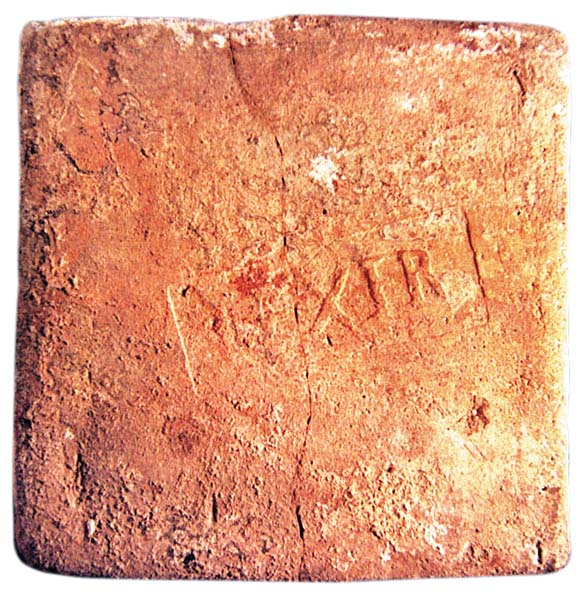
What Tepper and the prisoners exposed is probably the earliest church1 ever discovered in the Holy Land (the excavators date it to the first half of the third century, around 230 A.D.) and one of the very few churches from this early period anywhere in the world—from a time before Christianity became the religion of the Roman empire in the early fourth century during the reign of Constantine the Great.
Although Tepper had no idea of the church he would discover, he was hardly surprised that there were ancient remains here. Earlier archaeological surveys in the area (the most recent of which Tepper himself led) identified the site of an ancient Jewish village (Kfar Othnay), as well as the headquarters of two Roman legions and later the Byzantine city of Maximianopolis beside the Jewish village.
Kfar Othnay is mentioned in Jewish sources (Mishnah Gittin 7:7) and in Ptolemy’s writings, and is located on the famous Peutinger map (originally drawn in the second century A.D.), where it is called by its Latin name, Caporcotani. The excavation uncovered a number of miqva’ot (Jewish ritual baths) in Kfar Othnay, but they may have been used by the Samaritans rather than the Jews, because the sources also indicate that Othnay was home to Samaritans as well—a very multicultural place, as we shall see.
During the second and third centuries, the Romans erected a military camp near the Jewish village where at least two of their legions, the Second Traiana and the Sixth Ferrata, were stationed. The entire region then became known as Legio. The modern Arabic name of the site, El Lajjun, preserves a memory of the Roman military camp Legio. Dozens of roof tiles bear stamps of the Second Legion Traiana and the Sixth Legion Ferrata. A spectacular bronze statuette of the Roman house-god Lar was also recovered in the excavation.
At the end of the Roman period and during the Byzantine period, the Jewish village and Roman Legio became part of a city, or polis, named Maximianopolis in honor of the western emperor Maximian (286–305). A bishop from Maximianopolis attended the influential Council of Nicaea in 325, indicating that Maximianopolis remained an important Christian community even after the Roman legions left the site. Following the Arab conquest in the seventh century, Maximianopolis became the fortified capital of the district of Palaestina Secunda.
Perhaps the most interesting building in the area where the bronze statuette of the Roman god Lar was uncovered (Area Q) was a large structure at least 65 by nearly 100 feet (20 x 30 meters) at the edge of the Jewish village. This rectangular structure featured an open central courtyard surrounded on all sides by small rooms and halls.2 The building served several functions. Some of the rooms appear to have been dwellings for legionnaires and their families. (Overall the building was not unlike the other buildings in this residential quarter.) In the northern wing the archaeologists 041found juglets, cooking pots and basalt querns for grinding food. Other sections of the building served an administrative or military function. A Roman spearhead and knife were found in and around the building. Evidence of its function as a Roman military administrative center also includes two bread stamps. Bread was a staple of the Roman army diet, and it was customary for the military bakers to stamp their breads, either with the name of the Roman commander or the name of the baker.a Bread for the nearby Roman camp was apparently baked in the building. The names on the stamps, Lic[i](nius) Priscus and Jul(ius) Maxim(us), clearly demonstrate that the bakers were members of the Roman legion.
The southwest corner of this building served a religious function for the Christians who served in the army, as well as for the local Christian community. In the extreme southwest corner of the building is what the excavators call a Christian prayer hall measuring about 16 by 32 feet (5 x 10 meters).
Monolithic pilasters protruding from the walls were probably the bases for an arch rising above. Just under the center of the supposed arch were two rectangular stones pressed into the pavement of the hall. These were almost surely supports for a kind of table for the Eucharist (trapeza)—the symbolic imbibing of the blood and body of Christ in the wine and bread. Several liturgical tables from North Africa may give us an idea of what the altar/table at the Megiddo prayer hall looked like.
The most spectacular find in the excavation, however, was a beautifully preserved mosaic floor that clearly indicates the function of the room. On each of the four sides of the remains of the Eucharist table (the base of which the excavators call the podium) are individual mosaic panels outlined by straight rows of black tesserae. On the two side panels, the mosaic consists only of geometric panels.
On the front and back (north and south) are more elaborate panels. The one on the southern side contains two inscriptions facing one another. The one on the northern side contains not only an informative inscription, but also an elaborate rectangle enclosing eight smaller rectangles and rhombuses to form an internal octagon. Within the octagon, decorative tesserae transform the octagon into a circle or medallion. In the center of the medallion are two fish facing in opposite directions—a distinct Christian symbol for Christ.
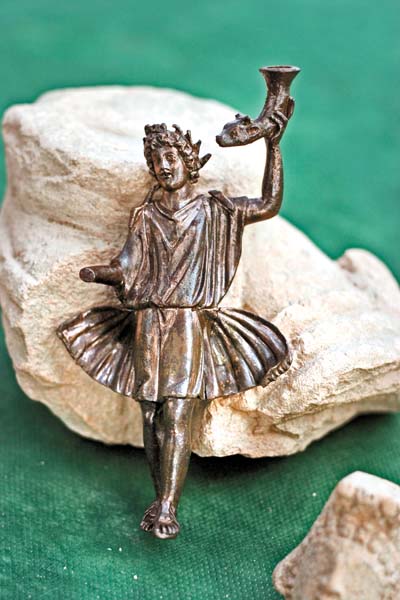
The Greek word for fish is ichthys. It is said to 042have been adopted as a Christian symbol because it contains the initial letters of the appellation “Jesus Christ, Son of God, Savior” in Greek (I[esous] Ch[ristos] Th[eou] Y[ios] S[oter]; Ι[ησουζ] Χ[ρισιοζ] Θ[εου] Υ[ιοζ] Σ[ωτηρ]). And of course fish are frequently referred to in the Gospels, in such incidents as the multiplication of the loaves and fishes (Matthew 14:16–21; 15:32–38; Mark 6:38–44; Luke 9:12–17), the prodigious fishing catch of Simon Peter in the Sea of Galilee (Luke 5:4–7) and the miraculous catch of a fish in whose belly Peter found a coin to pay the half-shekel tax for Jesus and himself in Capernaum (Matthew 17:24–27). At this time, the cross had not yet been adopted as the prime Christian symbol (see “Jesus Christ, God’s Son, Savior”).
The three Greek inscriptions in the mosaics, published by Israel’s leading Greek epigraphist Leah di Segni, to whom I am much indebted for this discussion, are in rectangular frames within the larger rectangular panels. The one on the northern side of the table base is a typical memorial inscription of four named women: Primilla, Cyriaca, Dorothea and Chreste. Scholars are already discussing what this inscription indicates about the place of women in the early church.
A second inscription, on the northern side on the right, honors the man who paid for the mosaic and the artisan who made it:
Gaianus, also called Porphyrius, centurion, our brother, has made the pavement at his own expense as an act of liberality. Brutius carried out the work.
This is a clear indication that the Christians who 043worshiped in this prayer hall were Roman soldiers. The donor of the prayer hall was a Roman officer, a centurion. That there was a community of congregants is indicated by use of the term “our brother.”
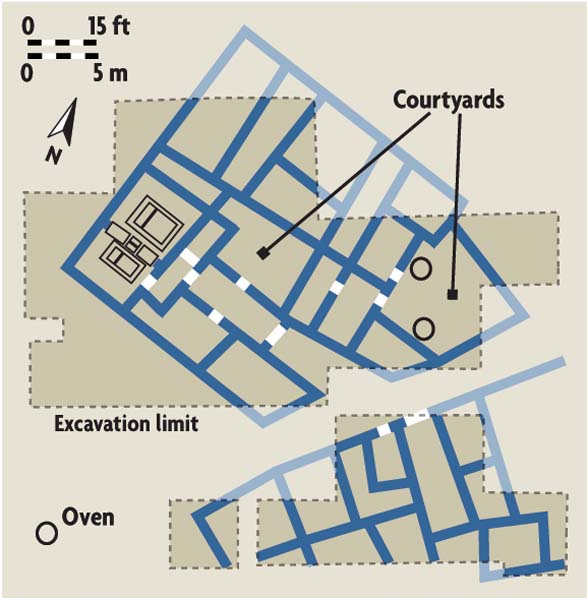
The third and final inscription makes it unmistakably clear that this place was intended to serve the religious needs of the Christian community organized in the Roman military camp. It also removes any doubt that a table once existed in the center of the hall—paid for by a woman named Akeptous: “The God-loving Akeptous has offered the table to God Jesus Christ as a memorial.”
The words “God Jesus Christ” on the next-to-last line are abbreviated in the form of a contraction consisting of the first and last letters of the two words. Above the two sacred words is a straight line. While these abbreviations and the line above indicating sacred words was later a common practice, this is their earliest attestation.b
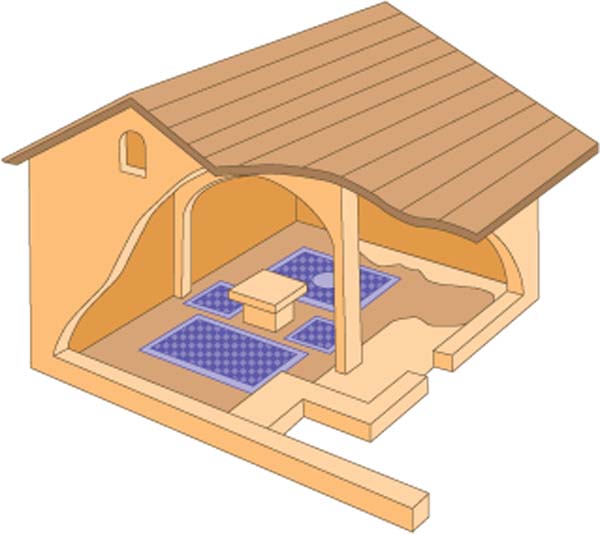
And this is the earliest inscription ever found in Israel, and perhaps anywhere, that mentions Jesus Christ!
The word “offer” is of special interest. The Greek prosferein (“to offer”) echoes language in the Gospels; for example, the Magi, following the star from the East, “offer” the baby Jesus gifts of gold, frankincense and myrrh (Matthew 2:11).
The word for memorial, mnemosynon, has its own story to tell. In Acts 10:4, where Cornelius the centurion becomes the first gentile convert to Christianity, an angel tells him that his prayers and alms have ascended as a memorial (mnemosynon).
The rooms adjacent to the prayer hall in this wing of the building served the multiple religious and social needs of the Christian community of Roman soldiers: vestries, baptisteries, confessionals, etc.
How can we date this building complex? There are a number of indications: pottery, coins and the paleography of the Greek inscriptions.
The excavators date the potsherds found beneath and above the floors of the building to the third century. A few sherds in one of the rooms have a larger chronological range, from the early third to early fourth centuries.
The numismatic evidence points to the same dates—that is, to the second, third and fourth centuries.
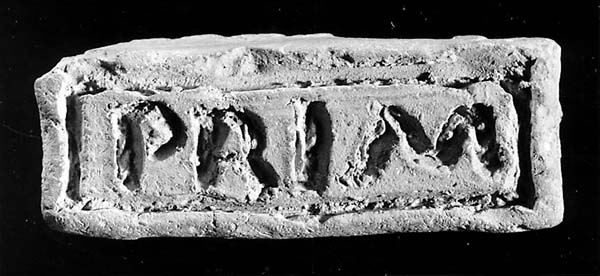
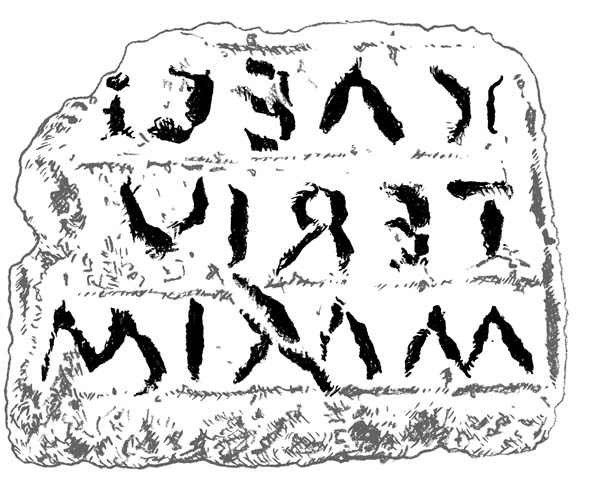
044
Epigraphist Leah di Segni is also comfortable with a third-century date based on the paleography and comparative forms in the inscriptions.
The excavator tentatively dates the construction of the building to the first third of the third century: a period that he suggests was a tranquil one for Christians. The calm was to be cut short by Maximinus, who became emperor in 235 and is well known for his persecution of Christian clergy.
In my judgment, based on a different historical context, I would date the construction to the second half of the third century. Although many Christians served in the Roman legions during the second and third centuries, the conversion of great numbers of legionnaires to Christianity occurred only in the second half of the third and the beginning of the fourth centuries.
The building was apparently abandoned late in the fourth century. The archaeologists found no sign of any conflagration, damage or destruction. On the contrary, it appears that before leaving, the occupants of the building took steps to protect the mosaic with a thick layer of plaster and pottery sherds. That is why it is now in such pristine condition.
The excavator suggests that the building was abandoned sometime during the reign of the eastern emperor Diocletian (284–305), who undertook a major reorganization of the Roman army. All of the 28 coins found in the building date to the third century or earlier. The occasion for the abandonment of the Legio building may have been the transfer of the headquarters of the Sixth Legion Ferrata.
The closest Christian religious structure to this one is a nearly contemporaneous building uncovered in the 1930s by Yale University at Dura Europos in Syria.3 It was an ordinary two-story dwelling converted into a Christian shrine. The well-preserved lower story contained an open central courtyard surrounded on three sides by rooms of various sizes and on the fourth by a portico. Although no clear evidence indicates whether the building was planned from the beginning as a religious structure or was an ordinary dwelling later converted to a church, the second alternative appears more likely, especially because three rooms underwent alterations designed to adapt them to religious functions. A partition that was removed created a prayer hall 16 by 42 feet (5 x 13 meters). Against the eastern wall was a raised platform upon which stood, very probably, the Eucharist table or the seat of the bishop. A small adjacent room was probably the vestry. Another became the baptistery.
The entire baptistery at Dura Europos was decorated with wall paintings depicting various Christian scenes: the Good Shepherd, Adam and Eve in Paradise, processions of praying women, several miracles of Christ, and others. Interestingly, fragments of frescoes that once covered the walls 045of the Megiddo structure housing the prayer hall were found lying on the floor. Geometric patterns were painted in blue, white, pink and yellow.
The Christian structure at Dura Europos is clearly dated to the first half of the third century. A prudent member of the community scratched into the fresh plaster a date for the alteration of a wall in the prayer hall (equivalent to 231 A.D.). The building was demolished in 257 to facilitate the erection of a new city wall.
Several other pre-Constantinian churches installed within ordinary houses are known from Greece and Rome. One was found on the island of Delos and another in Dion in southern Macedonia.4 Four other house churches were found in Rome, installed in private dwellings whose owners held legal title to the buildings.
Early Christians began to use house churches in the second century. The domus ecclesia (house church) replaced the “congregation room” used 048during the apostolic period and in the last decades of the first century.5 The house churches of the second century were not yet permanently dedicated as places of worship in the sense of a church (ecclesia). Christian assemblies moved from one dwelling to another in houses that belonged to the members of the community.
However, at the end of the second century and during the third, when the Christian communities acquired a more developed inner social organization, the provisional house church was abandoned in favor of a more permanent place dedicated not only to worship, but also to various other needs of the Christian community. Previously Christian worship had been based on prayers, sermons and communal dinners. By the third century, rituals officiated by ordained clergy were introduced. For this, different spaces were needed, such as baptisteries, vestries, confessionals, teaching rooms and special apartments for the clergy.
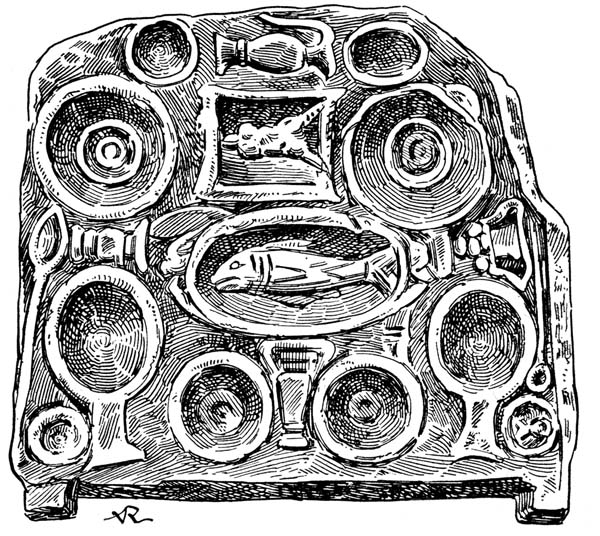
In addition, furnishings, such as the Eucharist Table (trapeza eucharistion) or the Offering Table (trapeza prosforon) became an integral part of Christian ritual, permanently fixed within the prayer hall.
The house churches of the third century had become similar to Jewish synagogues: They were communal centers meeting all the religious and social needs of the members of the community.6
During the third century, the church fathers referred to these house churches by different names, such as ecclesi,7 dominicum8 and domus Dei (House of God).9 The church father Minucius Felix (c. 200 A.D.) called them sacraria (shrines). He says they are found “all over the world” (per universum orbem).10 Origen (185–254) says these house churches are “the permanent place for the worship of God.”11
These house churches established the foundation for the future Christian church.
During the second half of the third century (until the Great Persecution of Diocletian between 303 and 313), Christians enjoyed a period of relative peace. The Roman emperors were engaged in civil wars. At this time Christians managed to enlarge existing houses of worship and build new ones. The church historian Eusebius (260–430) describes “those assemblies thronged with countless men, and the multitudes that gathered together in every city, and the famed concourses in the places of prayer; by reason of which they were no longer satisfied with the buildings of olden time, and would erect from the foundations churches of spacious dimensions throughout all the cities.”12
The second half of the third century was also a formative time in the development of the mode of worship. The simple gatherings for prayer evolved into the Divine Liturgy. The rite of Eucharist became one of the most important Christian sacraments. As such, it was performed in the most prominent place in the church, on the bema (dais) located at the eastern end of the prayer hall.
Finally, all this culminated in a kind of church structure that was accepted by all Christians. In the early fourth century, during Constantine’s reign, Christianity became the religion of the Roman empire. Several monumental churches (such as the basilicas built over the tomb of Jesus in Jerusalem and the one over his birthplace in Bethlehem) were built in the mid-fourth century as an expression of the triumph of Christianity. With those exceptions, however, churches were built according to traditions established during the last decades of the third century. Responding to these new traditions, the universal architectural plan for the Christian church was the basilica, borrowed from Greek and Roman architecture.

049
One such early basilica dating to the first half of the fourth century was recently excavated in Aqaba (ancient Aila) on the Red Sea, just across the border between Israel and Jordan. Two other basilical churches from the early fourth century were excavated: one in Salona on the Dalmatian coast of Greece and the other in Aquileja, Italy, on the northern Adriatic coast.
Into this brief history of church architecture, we must fit the church in the Megiddo prison complex.
In the late 1990s, authorities at the prison that sits near the base of Tel Megiddo in northern Israel decided they needed more room. Accordingly, an addition was planned within the prison compound and work commenced. It was not long, however, before the construction workers (prisoners) hit ancient remains. Work on the prison extension was immediately stopped and the Israel Antiquities Authority notified. A so-called salvage, or rescue excavation was organized under the direction of archaeologist Yotam Tepper, and the archaeologists were soon in the field. (The prisoners also helped; Tepper dedicates his popular pamphlet on 040 the excavation […]
You have already read your free article for this month. Please join the BAS Library or become an All Access member of BAS to gain full access to this article and so much more.
Already a library member? Log in here.
Institution user? Log in with your IP address or Username
Footnotes
A Roman bread stamp found in Jerusalem was recently published in BAR. See Eilat Mazar, “Hadrian’s Legion Encamped on the Temple Mount,” BAR 32:06.
George Howard, “The Name of God in the New Testament,” BAR 04:01.
Endnotes
The excavator and epigraphist call it a prayer hall, rather than a church, because it is not a separate building in the plan of later churches. They also prefer prayer hall to domus ecclesia (house church) because the building was owned privately rather than by the Christian community. In common parlance, however, the prayer hall would certainly be considered a church.
Yotam Tepper and Leah di Segni, A Christian Prayer Hall of the Third Century C.E. at Kefar Óthnay (Legio) (Jerusalem: IAA Publications, 2006).
Clark Hopkins, The Excavations at Dura-Europos, by Mikhail Rostovtzeff (New Haven, CT: Yale Univ. Press, 1934), pp. 238–253, pl. xxxix.
Lee I. Levine, “Ancient Synagogues—A Historical Introduction” in Ancient Synagogues Revealed (IEC Publications, 1981), pp. 1–5.
